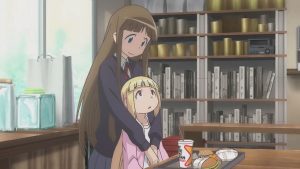Nicknamed “the Red Queen” due to her immense powers, Sana is a young girl with the ability to create anything that she is able to imagine. Having escaped from a secret facility where she was being housed as a test subject, Sana makes her way to Shinjuku where she runs into an elderly and disgruntled florist by the name of Zoroku Kashimura. While Zoroku initially wants nothing to do with this cheeky brat and her limitless powers, he eventually offers Sana a place to stay with him and his daughter Sanae. But as Sana begins to acclimatise to her new life, it becomes clear that she has a long way to go before she gains control over her powers, and that the facility she escaped from is not finished with her yet.

Alice and Zoroku is a modern fantasy with elements of a magical girl and slice of life anime. The series also loosely plays around with concepts from Alice in Wonderland, with people like Sana who have special powers known as “Dreams of Alice”, the existence of a place called Wonderland, and in general just using the familiar trappings and aesthetic of the Alice and Wonderland world to pad out the show (more on this later).
This results in Alice and Zoroku having a somewhat sporadic and confusing identity, and the series struggles to balance all these different elements and deliver on its concepts in any meaningful way. This is a shame because the series begins relatively engaging, focusing more on the magical girl aspect of Sana’s powers as she runs from those who want to return her to the facility where she was being experimented on. The relationship established between Sana and Zoroku is also neat, as the two have a fun character dynamic where Sana’s bratty nature and Zoroku’s straightforward, quick-to-irritate personality continously collide. Unfortunately, the series struggles to feel cohesive the further it progresses, so much so that it almost becomes off-putting – a perfect example of the dissonance is the depiction of cutesy magical girl shenanigans in one episode, followed by another episode where Sana is kidnapped and tormented by someone working for the facility. Despite this, the first handful of episodes deliver a complete story that shows Sana escaping her captors and finding a family. This means that when the series transitions into its second arc and takes on more slice of life elements, it has already explored and wrapped up the more engaging and emotional elements of Sana’s story. As a result, the second half of the series lacks the heart of its previous episodes and struggles to introduce any new characters or themes of any interest or consequence.

I previously discussed in a past review that Japanese media has a sub-sub-genre that takes historical figures and uses aspects of these figures to create characters and a narrative completely removed from their original context. As a book within the public domain, Alice in Wonderland tends to get a similar treatment and is often used as a loose framework from which to hang many narratives from. As is usually the case for stories that use public domain concepts to pad out their own content, the Alice in Wonderland inspired backdrop of Alice and Zoroku is inconsequential. The Dreams of Alice, Sana’s monicker of “Red Queen” and even the Wonderland that Sana visits in later episodes of the series could have all been replaced with different names and dressings and there would be no impact whatsoever to the overall narrative. I bring this up because the lack of any meaningful reason behind the addition of Alice in Wonderland to this series is part of its failure. The use of Alice in Wonderland and the series’ inability to make it matter outside of empty references to white rabbits and red queens is indicative of a larger problem; the series tries to be so many things it can be none of them well. It borrows elements from Alice in Wonderland, magical girl anime and slice of life anime, but is ultimately unable to balance these different elements or say anything meaningful about them individually, let alone as a whole.

Alice and Zoroku is a mixed bag of a show. The first few episodes are engaging enough – Sana’s plight to escape the facility is effective, and the show has some fun and wacky concepts that at the very least make you want to keep watching, like a Dreams of Alice who fights with literal disembodied arms. But the important emotional stakes of the show are basically resolved halfway through the series and once that is out of the way all that is left is a meaningless thematic connection to Alice in Wonderland that is purely about the aesthetic rather than having anything meaningful or interesting to say.
A review copy was provided by Madman Entertainment to the author for the purpose of this review.





